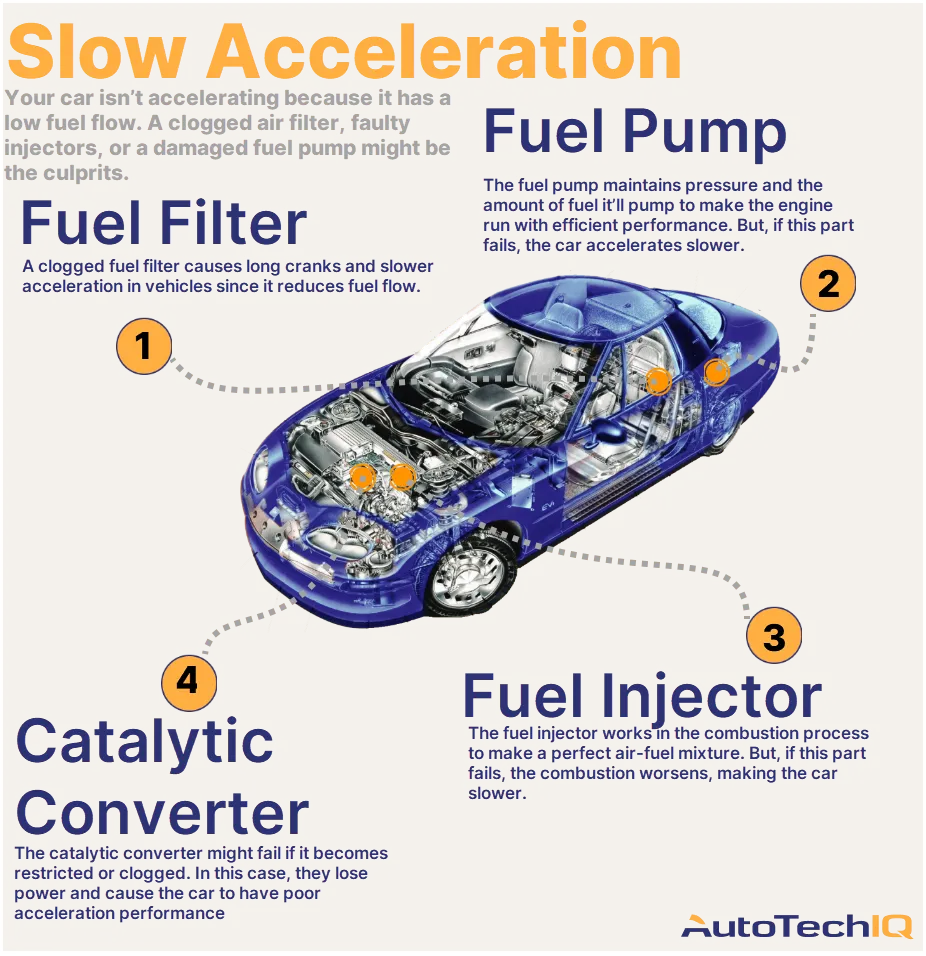Unplugging the mass air flow sensor can cause a car to run better due to increased fuel delivery, but it may lead to long-term engine damage.
What Is A Mass Air Flow Sensor
The mass air flow sensor is a critical component in a car’s engine management system, responsible for measuring the amount of air entering the engine. If a car runs better with the mass air flow sensor unplugged, it could indicate a faulty sensor, clogged air filter, or a vacuum leak.
Regular maintenance and cleaning of the sensor can help avoid these issues.
A Mass Air Flow (MAF) sensor is a crucial component of a car’s engine management system. It measures the amount of air entering the engine and provides this data to the Engine Control Unit (ECU). The ECU uses this information to calculate the appropriate fuel-to-air ratio for efficient combustion, ensuring optimal engine performance.
Function Of A Mass Air Flow Sensor
The primary function of a Mass Air Flow sensor is to accurately measure the volume and density of the air entering the engine. It does this by using a heated wire or film that is cooled down by the incoming air. As the wire cools, the MAF sensor detects the change in electrical current and converts it into a voltage signal. This voltage signal is then sent to the ECU, which uses it to adjust the fuel injection and ignition timing.
The MAF sensor plays a crucial role in maintaining the right air-to-fuel ratio, allowing for optimized combustion and efficient engine performance. It ensures that the engine receives the right amount of fuel for the air entering the combustion chamber, leading to smoother acceleration, improved fuel efficiency, and reduced emissions.
Importance Of A Mass Air Flow Sensor
The Mass Air Flow sensor is a vital component that directly impacts the overall performance of a car. Its accurate readings enable the engine to operate at its peak efficiency, resulting in improved fuel economy and reduced emissions. Without a properly functioning MAF sensor, the engine may experience various issues such as:
- Poor acceleration
- Decreased power output
- Engine stalling or hesitation
- Increased fuel consumption
- Unstable idle
It is crucial to keep the MAF sensor clean and in good working condition to ensure optimal engine performance. Regular maintenance and periodic inspection of the sensor can help identify any issues early on and prevent further damage to the engine.
If you suspect a problem with your Mass Air Flow sensor, it is important to address it promptly. Cleansing the sensor using a specialized MAF cleaner may solve minor issues caused by dirt or debris. However, if the sensor is faulty or damaged, replacement might be necessary to restore proper engine function.
Overall, the Mass Air Flow sensor plays a critical role in the engine management system. Its accurate measurements and proper functioning are essential for a car to run smoothly, efficiently, and at its best performance. Regular inspection and maintenance of this sensor can help prevent potential issues and ensure a trouble-free driving experience.
Credit: www.quora.com
Symptoms Of A Faulty Mass Air Flow Sensor
A faulty mass air flow sensor can cause a variety of symptoms in a car. One common issue is that the car runs better with the mass air flow sensor unplugged. This can be caused by a faulty sensor or a problem with the sensor’s connection.
Fixing the issue may involve cleaning or replacing the sensor, or addressing any wiring problems.
The mass airflow (MAF) sensor is a crucial component of your car’s engine management system. When malfunctioning, it can lead to various issues, resulting in diminished performance. It’s important to recognize the symptoms of a faulty mass airflow sensor to address the problem promptly and ensure optimal operation of your vehicle.Engine Misfires
One of the telltale signs of a faulty mass airflow sensor is persistent engine misfires. These misfires can cause rough idling and a noticeable decrease in engine performance. The MAF sensor plays a key role in measuring the amount of air entering the engine, and when it fails, the air-fuel mixture may become imbalanced, leading to misfires.Poor Fuel Efficiency
A faulty mass airflow sensor can also result in poor fuel efficiency, causing your car to consume more fuel than usual. This can be attributed to inaccurate readings from the MAF sensor, leading to an improper air-fuel mixture. As a result, your engine may burn more fuel than necessary, impacting your vehicle’s overall mileage.Stalling And Poor Acceleration
Another common symptom of a faulty MAF sensor is stalling and poor acceleration. You may notice your car struggling to accelerate, especially when attempting to pick up speed from a standstill. Additionally, stalling can occur during idling or when coming to a stop. These issues are often directly linked to irregular airflow readings caused by a malfunctioning MAF sensor.To ensure the optimal performance of your vehicle, it’s imperative to address these symptoms promptly. Regular maintenance and timely replacement of the MAF sensor can help prevent these issues. By staying vigilant and proactive, you can avoid potential damage to your engine and ensure a smooth driving experience.Causes Of A Faulty Mass Air Flow Sensor
Understanding the causes of a faulty mass air flow sensor is crucial for maintaining the optimal performance of your car engine. A faulty mass air flow sensor can lead to various issues, such as decreased fuel efficiency, rough idling, or power loss. In this section, we will explore three common causes of a faulty mass air flow sensor: dirty or contaminated sensor, electrical issues, and component failure.
Dirty Or Contaminated Sensor
One of the most common causes of a faulty mass air flow sensor is dirt or contamination. Over time, dust, debris, and oil particles can accumulate on the sensor, affecting its ability to accurately measure the airflow entering the engine. This can result in incorrect air-fuel ratios, leading to engine misfire, stalling, or surging. Regularly cleaning the mass air flow sensor can help prevent this issue.
Electrical Issues
Electrical problems can also cause the mass air flow sensor to malfunction. Faulty wiring connections, corrosion, or a damaged connector can disrupt the proper communication between the sensor and the engine control unit. This can result in incorrect readings and adversely affect the engine’s performance. If you suspect an electrical issue, it is advisable to check the wiring connections and inspect the sensor’s connector for any signs of damage or corrosion.
Component Failure
In some cases, component failure can be responsible for a faulty mass air flow sensor. The delicate sensor element within the mass air flow sensor can become damaged or worn out due to age, exposure to extreme temperatures, or contaminated air. This can lead to inaccurate airflow measurements and negatively impact the engine’s performance. If other troubleshooting steps fail to resolve the issue, replacing the mass air flow sensor might be necessary.
Effects Of Running A Car With A Faulty Mass Air Flow Sensor
A faulty mass air flow sensor in a car can lead to various effects, including decreased fuel efficiency, rough idling, and hesitation during acceleration. Unplugging the sensor may temporarily improve performance, but it is not a recommended solution. Having the sensor repaired or replaced is the appropriate fix to ensure optimal functioning of the vehicle.
Increased Emissions
Running a car with a faulty mass air flow (MAF) sensor can lead to increased emissions, affecting both the environment and your vehicle’s performance. The MAF sensor measures the airflow entering the engine and helps the engine control unit (ECU) determine the correct fuel-to-air ratio.
When the MAF sensor is faulty, it may send incorrect information to the ECU, causing an imbalance in the fuel-to-air ratio. This imbalance can result in a rich or lean mixture, leading to excessive emissions of harmful gases such as carbon monoxide (CO) and nitrogen oxide (NOx). These emissions can contribute to air pollution and may cause your vehicle to fail emissions tests, resulting in potential fines or restrictions on usage.
Risk Of Engine Damage
Running a car with a faulty MAF sensor also poses a risk of engine damage. The ECU relies on accurate data from the MAF sensor to adjust the fuel injection and ignition timing properly. Without the correct information, the engine may experience irregular combustion, leading to misfires, decreased power, and potential overheating.
Over time, these irregular combustion events can cause damage to various engine components, including the spark plugs and catalytic converter. Ignoring or neglecting a faulty MAF sensor can result in costly repairs and reduced engine lifespan. It is essential to address the issue promptly to prevent further damage and ensure the longevity of your vehicle.
Why A Car Runs Better With The Mass Air Flow Sensor Unplugged
Have you ever noticed that your car runs better with the mass air flow sensor unplugged? It can be quite puzzling to understand why turning off a crucial sensor can actually improve your car’s performance. In this section, we’ll delve into the reasons behind this phenomenon and explore the changes in air-fuel mixture and bypassing faulty sensor that contribute to a car running better with the mass air flow sensor unplugged.
Changes In Air-fuel Mixture
Unplugging the mass air flow sensor can lead to changes in the air-fuel mixture, which is essential for optimal engine performance. This sensor measures the amount of air entering the engine, allowing the engine control unit (ECU) to adjust the fuel injection accordingly. When the sensor is faulty or dirty, it may provide inaccurate readings, leading to a skewed air-fuel mixture. By disconnecting the sensor, the ECU reverts to a default air-fuel ratio, which may align better with the engine’s actual needs, resulting in improved performance.
Bypassing Faulty Sensor
Another reason a car runs better with the mass air flow sensor unplugged is that it effectively bypasses a faulty sensor. A malfunctioning mass air flow sensor can cause issues such as hesitation, rough idling, and poor acceleration. By unplugging the sensor, the ECU stops relying on its input, potentially mitigating these problems and allowing the engine to operate more smoothly. However, it’s important to note that while this temporary fix may alleviate symptoms, it’s crucial to address the underlying issue by either cleaning or replacing the sensor to ensure long-term performance.

Credit: www.autotechiq.com
Temporary Fix: Unplugging The Mass Air Flow Sensor
Unplugging the mass air flow sensor can provide a temporary fix for a car that runs better with it unplugged. This can be caused by certain sensor issues or air flow restrictions. However, fixing the underlying problem is essential for long-term performance.
You may have heard the claim that unplugging the mass air flow (MAF) sensor can temporarily improve the performance of your car. But is it true? What causes this improvement and are there any risks or limitations involved? In this blog post, we will explore the procedure for unplugging the sensor, potential risks, and limitations, so you can make an informed decision.
Procedure For Unplugging The Sensor
If you choose to temporarily unplug the MAF sensor, here is a step-by-step procedure to follow:
- Locate the MAF sensor, which is usually found between the air filter and the throttle body.
- Identify the electrical connector attached to the sensor.
- Use your fingers or a screwdriver to carefully disconnect the connector by pressing the release tab and pulling it apart.
- Once the connector is disconnected, start your car and see if there is any improvement in its performance.
Please keep in mind that this is a temporary fix, and you should reconnect the sensor as soon as possible to ensure the proper functioning of your vehicle.
Potential Risks And Limitations
While unplugging the MAF sensor may provide a temporary improvement in car performance, it is essential to be aware of the potential risks and limitations:
The risks include:
- Increased fuel consumption due to the engine running in a default mode.
- Potential damage to the catalytic converter or oxygen sensors.
- The risk of contaminating the engine with unfiltered air, leading to accelerated wear and tear.
- Possible errors in the vehicle’s diagnostic system, making it harder to identify underlying issues.
Moreover, unplugging the MAF sensor does not address the root cause of any problems you may be experiencing. It should not be considered a permanent solution but rather a temporary measure until the underlying issue can be properly diagnosed and fixed.
It is crucial to consult a qualified mechanic or technician to thoroughly inspect your vehicle and diagnose any potential issues before deciding to unplug the MAF sensor. They can provide you with the appropriate guidance and ensure the long-term reliability of your car.
Remember, unplugging the MAF sensor should only be done in exceptional circumstances and as a last resort, and it is always recommended to consult a professional for a complete diagnosis and appropriate repairs.
Permanent Fix: Replacing Or Cleaning The Mass Air Flow Sensor
A simple fix for better car performance is cleaning or replacing the mass air flow sensor. Disconnecting the sensor can cause temporary improvement, but a permanent solution is essential for optimal running of the vehicle.
Signs Of A Faulty Sensor
If your car is not running smoothly, one of the potential culprits could be a faulty mass air flow sensor. This crucial component is responsible for detecting the amount of air entering the engine and adjusting the fuel injection accordingly. When the mass air flow sensor is faulty, it can cause an imbalance in the air-to-fuel ratio, leading to poor engine performance, reduced fuel efficiency, and potential damage to other engine components.
Here are some key signs that indicate a faulty mass air flow sensor:
- Check Engine Light: If the sensor is not functioning properly, it can trigger the check engine light on your dashboard. It’s important not to ignore this warning sign as it could indicate a range of issues, including a faulty mass air flow sensor.
- Poor Acceleration: A faulty sensor can cause hesitation or jerky acceleration when you press the gas pedal. This can be particularly noticeable when accelerating from a stop or when trying to overtake another vehicle.
- Stalling or Rough Idle: When the mass air flow sensor is malfunctioning, it can lead to a rough idle or even stalling of the engine. If you notice your car idling roughly or frequently stalling, it may be time to check the sensor.
- Decreased Fuel Efficiency: A faulty sensor can disrupt the air-to-fuel ratio, leading to increased fuel consumption. If you find yourself visiting the gas station more frequently than usual, a faulty mass air flow sensor could be the cause.
- Unusual Exhaust Emissions: If the sensor is not providing accurate readings, it can result in abnormal exhaust emissions. You may notice black smoke, a sulfur-like smell, or a decrease in the overall cleanliness of the exhaust.
Cleaning The Mass Air Flow Sensor
Cleaning the mass air flow sensor is often the first step to try when addressing issues related to a faulty sensor. Over time, the sensor can become dirty or contaminated with debris, affecting its ability to accurately measure the air intake. Cleaning the mass air flow sensor can sometimes restore proper functionality without the need for replacement.
Here are the steps to clean the mass air flow sensor:
- Locate the sensor: The mass air flow sensor is typically located between the air filter housing and the engine’s intake manifold. Consult your vehicle’s manual for the exact location.
- Disconnect the sensor: Carefully disconnect the electrical connector attached to the sensor.
- Remove the sensor: Remove any screws or clips securing the sensor in place, then gently remove the sensor from its housing.
- Clean the sensor: Use a specialized mass air flow sensor cleaner to clean the delicate components of the sensor. Avoid using regular household cleaners as they can damage the sensor. Follow the product instructions carefully.
- Reinstall the sensor: Once the sensor is thoroughly cleaned and dry, carefully reinstall it, making sure it is properly secured.
- Reconnect the electrical connector: Reattach the electrical connector to the sensor.
Note: If cleaning the sensor does not resolve the issue or if the sensor is visibly damaged, it may be necessary to replace it with a new one.
Replacing The Mass Air Flow Sensor
If cleaning the mass air flow sensor does not improve the performance of your car or if the sensor is faulty beyond repair, replacing it with a new one is the best course of action. Replacing the mass air flow sensor ensures accurate air flow measurements and reliable engine performance.
Here’s what you need to know about replacing the mass air flow sensor:
- Compatibility: Ensure that you purchase a replacement sensor that is compatible with your vehicle’s make, model, and year.
- Quality: Choose a high-quality mass air flow sensor from a reputable manufacturer to ensure long-lasting performance.
- Installation: Follow the manufacturer’s instructions for installation. It is recommended to consult a professional mechanic if you are not confident in performing the replacement yourself.
- Resetting the ECU: After replacing the sensor, it may be necessary to reset the engine control unit (ECU) to clear any error codes and allow the new sensor to function properly. Consult your vehicle’s manual or a mechanic for guidance on resetting the ECU.
Replacing a faulty mass air flow sensor can greatly improve the overall performance and fuel efficiency of your car, ensuring a smoother and more enjoyable driving experience.

Credit: www.amazon.com
Conclusion
In essence, the mass air flow sensor plays a crucial role in a car’s performance. When left unplugged, it can trigger issues with the engine, fuel efficiency, and overall drivability. To ensure optimal vehicle operation, it’s essential to diagnose and fix any problems related to the mass air flow sensor promptly.
Regular maintenance and professional assistance are key to keeping your car running smoothly.


